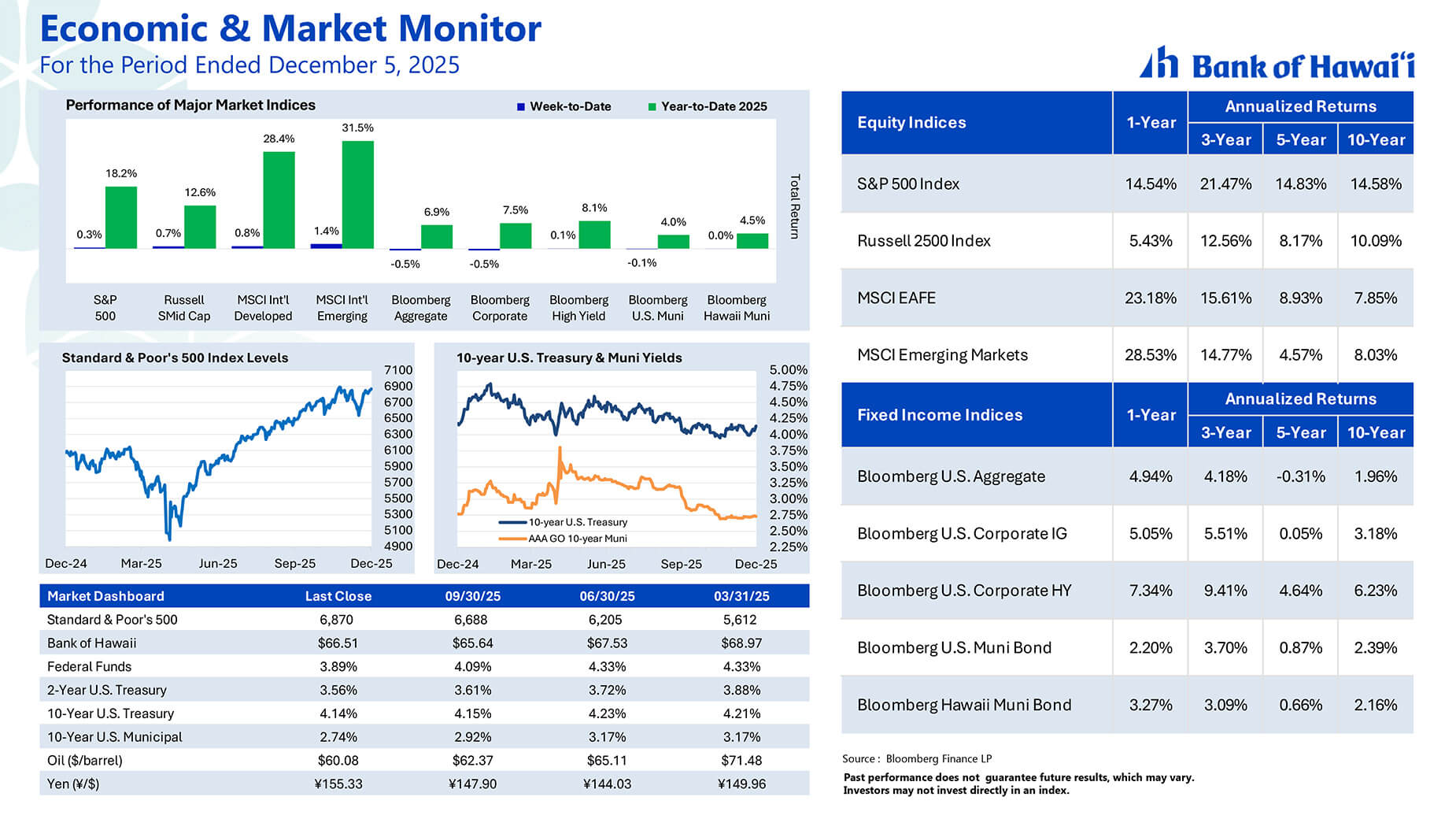Economic & Market Monitor
For the period ending December 5, 2025
Market Review
Stocks Edge Higher: The S&P 500 Index came close to setting a record high on Friday before trimming its gains later in the day. The index edged up 0.3% for the week, bringing its year-to-date return to 18.2%. Stocks within the energy and technology sectors led the S&P’s advance. Energy stocks benefited from a weather-related jump in oil and gas prices. Stock market gains extended abroad, with the MSCI developed and emerging market indexes advancing 0.7% and 1.4%, respectively. Year-to-date returns in these markets rose to 28.4% and 31.5%.
Yield Curve Steepens: Short-term interest rates dropped last week on growing conviction that the Federal Open Market Committee (FOMC) will cut the fed funds rate by 0.25% on December 10th. However, longer-term rates shifted higher. The yield on one-month U.S. Treasury bills slipped by 0.24% to 3.69%, while the yield on ten-year notes climbed 0.12% to 4.14%. The upward shift in note rates appeared to be related to a jump in Japanese interest rates and inflation fears triggered by last week’s higher energy prices. With longer-term rates higher, the Bloomberg Aggregate and Bloomberg U.S. Municipal Bond Indices slipped 0.5% and 0.1%, respectively, lowering their year-to-date gains to 6.9% and 4.0%.
Mixed Jobs Data: On Tuesday, ADP Research reported that private-sector payrolls dropped by 32,000 in November, falling short of the Bloomberg median forecast, which called for an increase of 10,000. On a positive note, two days later, the Department of Labor reported that initial claims for jobless benefits for the week ended November 29th fell to 191,000 from 218,000 the prior week—well below the Bloomberg median forecast of 220,000.
Economy Expanding: S&P Global reported its November U.S. Composite Purchasing Managers Index (PMI) at 54.2. The PMI measures business activity in both services and manufacturing sectors, with readings above 50 reflecting expansionary conditions.
Consumer Sentiment Improved Slightly in December: The University of Michigan’s preliminary December Consumer Sentiment Index rose to 53.3 from 51 in November—its first increase in five months. The gain was concentrated in responses from younger survey participants. Despite the improvement, the index remains near historically low levels.
PCE as Expected: On Friday, the Bureau of Economic Analysis (BEA) released the Federal Reserve’s preferred inflation measure for September, the Core Personal Consumption Expenditures (PCE) Price Index. The PCE rose 2.8% year-over-year, precisely in line with the Bloomberg median forecast, and slightly below August’s 2.9%. The Fed’s longer-term inflation target is 2%.
Outlook
Market attention this week will focus on commentary and data releases following the FOMC’s December meeting, scheduled to conclude during market trading hours on Wednesday. As of Friday, fed funds futures implied a 96% probability of a 0.25% cut in the fed funds target rate range to 3.50%–3.75%. The FOMC’s quarterly Summary of Economic Projections (SEP) will provide key insights into changes in the committee’s outlook over the last three months. Forecasters anticipate some weakening of the FOMC’s forecast for Q4 GDP and the unemployment rate due to the prolonged government shutdown. The “dot plot” forecast for the fed funds rate at the end of next year will be of particular interest because fed funds futures, as of Friday, implied a significantly lower rate (3%) than the FOMC’s September plot (3.4%). This leaves room for disappointment, particularly if Fed Chairman Jerome Powell’s press conference commentary is perceived as “hawkish” rather than accommodative with respect to the future direction of rates.
Roger Khlopin, CFA
Chief Investment Officer
Aaron Nghiem, CFA, CIMA
Senior Portfolio Manager
This material is provided for educational purposes only and is not intended to be relied upon as a forecast, research, or investment advice, and is not a recommendation, offer or solicitation to buy or sell any securities or to adopt any investment strategy. Bank of Hawaii and its affiliates do not provide tax, legal or accounting advice. This material is not intended to provide, and should not be relied on for, tax, legal, or investment advice. You should consult your own tax, legal, accounting or financial professional before engaging in any transaction. Neither the information nor any opinions expressed herein should be construed as a solicitation or a recommendation by Bank of Hawaii or its affiliates to buy or sell any securities, investments, or insurance products. Investing involves market risk, including possible loss of principal, and there is no guarantee that investment objectives will be achieved. Past performance is not a guarantee of future results.
You're about to exit BOH.com
Links to other sites are provided as a service to you by Bank of Hawaii. These other sites are neither owned nor maintained by Bank of Hawaii. Bank of Hawaii shall not be responsible for the content and/or accuracy of any information contained in these other sites or for the personal or credit card information you provide to these sites.




